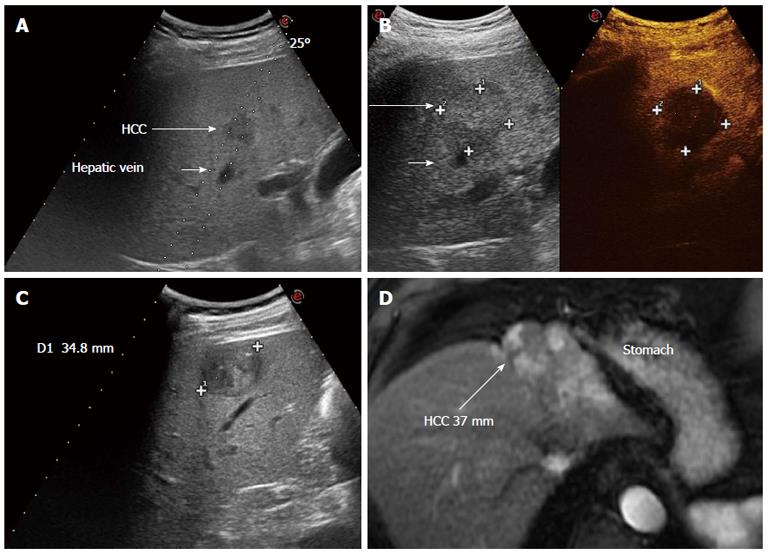Copyright
©2013 Baishideng Publishing Group Co.
World J Gastroenterol. Jul 14, 2013; 19(26): 4106-4118
Published online Jul 14, 2013. doi: 10.3748/wjg.v19.i26.4106
Published online Jul 14, 2013. doi: 10.3748/wjg.v19.i26.4106
Figure 2 Clinical cases in which performing hepatic resection or radiofrequency ablation had to be decided.
A: Ultrasonography through a right inter-costal scan shows a very early hepatocellular carcinoma (HCC) in segment 5 that can be reached with a safe needle track for thermal ablation. Given the small size and easy access, radiofrequency ablation was carried out; B: Post treatment assessment with contrast enhanced ultrasound shows a necrotic devascularized area (34 mm × 35 mm) that includes the tumor with a safety margin > 5 mm; C: Superficial HCC of 35 mm in hepatitis B virus related cirrhosis with preserved liver function. This lesion could be treated by either ablation or resection, but resection is preferable given the superficial location in segment 5 and the size > 3 cm; D: Tumor lesion partially treated by a previous trans-catheter arterial chemoembolization performed in another hospital, in a sub-capsular location close to the stomach. The theoretical path for radiofrequency ablation would lead the needle to puncture the tumor directly and thermal ablation would imply a risk of heat damage to the stomach wall. Laparoscopic resection was the strategy adopted. The long arrow indicates the HCC after treatment.
-
Citation: Cucchetti A, Piscaglia F, Cescon M, Ercolani G, Pinna AD. Systematic review of surgical resection
vs radiofrequency ablation for hepatocellular carcinoma. World J Gastroenterol 2013; 19(26): 4106-4118 - URL: https://www.wjgnet.com/1007-9327/full/v19/i26/4106.htm
- DOI: https://dx.doi.org/10.3748/wjg.v19.i26.4106









